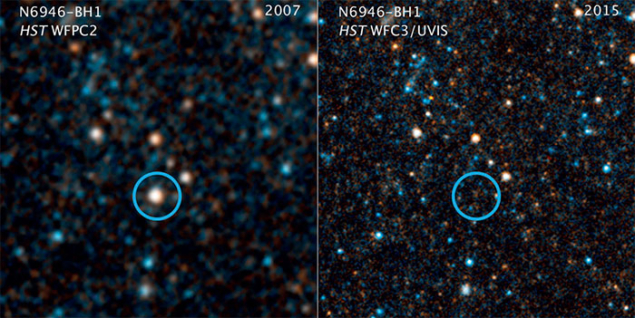
Image credit: NASA/ESA/C Kochanek.
Massive stars are traditionally expected to end their life cycle by triggering a supernova, a violent event in which the stellar core collapses into a neutron star, potentially followed by a further collapse into a black hole. During this process, a shock wave ejects large amounts of material from the star into interstellar space with large velocities, producing heavy elements in the process, while the supernova outshines all the stars in its host galaxy combined.
In the past few years, however, there has been mounting evidence that not all massive-star deaths are accompanied by these catastrophic events. Instead, it seems that for some stars only a small part of their outer layers is ejected before the rest of the volume collapses into a massive black hole. For instance, there are hints that the birth rate and supernova rate of massive stars do not match. Furthermore, results from the LIGO gravitational-wave observatory in the US indicate the existence of black holes with masses more than 30 times that of the Sun, which is easier to explain if stars can collapse without a large explosion.
The results would explain why we observe less supernovae than expected
Motivated by this indirect evidence, researchers from Ohio State University began a search for stars that quietly form a black hole without triggering a supernova. Using the Large Binocular Telescope (LBT) in Arizona, in 2015 the team identified its first candidate. The star, called N6946-BH1, was approximately 25 times more massive than the Sun and lived in the Fireworks galaxy, which is known for hosting a large number of supernovae. Previously presenting a stable luminosity, the star was seen to become brighter, although not at the level expected for a supernova, during 2009, before completely disappearing in optical wavelengths in 2010 (see image).
The lack of emission observed by the LBT triggered follow-up searches for the star, both using the Hubble Space Telescope (HST) and the Spitzer Space Telescope (SST). While the HST did not find signs of the star in the optical wavelength, the SST did observe infrared emission. A careful analysis of the data disfavoured alternative explanations such as a large dust cloud obscuring the optical emission from the star, and the infrared data were also shown to be compatible with emission from remaining matter falling into a black hole.
If the star did indeed directly collapse into a black hole, as these findings suggest, the in-falling matter is expected to radiate in the X-ray region. The team is therefore waiting for observations from the space-based Chandra X-ray Observatory to search for this emission.
If confirmed in X-ray data, this result would be the first measurement of the birth of a black hole and the first measurement of a failed supernova. The results would explain why we observe less supernovae than expected and could reveal the origin of the massive black holes responsible for the gravitational waves seen by LIGO, in addition to having implications for the production of heavy elements in the universe.







